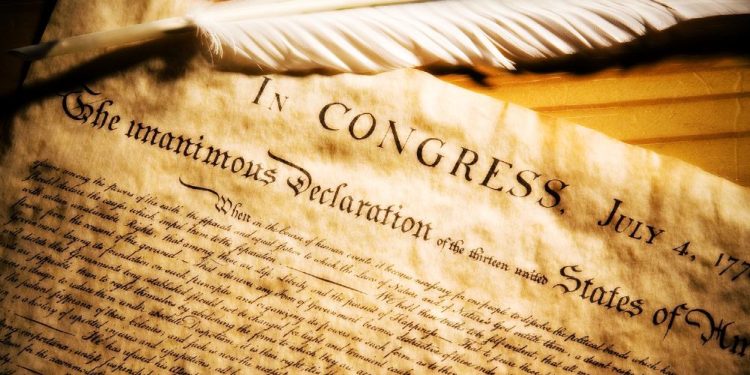Happy Fourth of July, America! I was recently reflecting upon the history surrounding the Declaration of Independence and thought my readers would also be very interested to learn some often unknown aspects of the Declaration’s creation, distribution and legacy.
Several historical websites hold some fascinating facts about this national treasure, including the National Archives in Washington, D.C. History.com’s article, “9 Things You May Not Know about the Declaration of Independence,” by Elizabeth Harrison, has some intriguing information, too. Let me elaborate on some of those and convey a few others I’ve discovered.
1. Benjamin Franklin wrote the first “declaration of independence.”
In April 1775, the American Revolutionary War began at Lexington and Concord. On July 5, 1775, a entire year before the adoption of the Declaration of Independence, the Continental Congress adopted the Olive Branch Petition, written by John Dickinson with the help of Thomas Jefferson. It appealed directly to King George III for reconciliation between the American colonies and Great Britain.
Though Benjamin Franklin signed the Petition for the sake of consensus, he radically differed with it and said that stronger sentiments were necessary because the Petition was destined to be rejected.
Franklin was so appalled by British atrocities and exhausted of their rule that he planned the first articles of confederation and drafted a declaration of independence to be issued by none other than Gen. George Washington.
So strong was the language of the draft that Thomas Jefferson wrote, while some members of Congress like himself “approved highly of it,” others would be “revolted at it.” Jefferson explained in his private commentary that “proposing it to congress as the subject for any vote whatever would startle many members.”
It seems Congress just wasn’t ready to throw down the gauntlet, yet. My, how things can change in a year!
2. Thomas Jefferson had problems with the adopted version of the Declaration of Independence – written largely by him.
On June 11, 1776, the Second Continental Congress appointed a committee of five men (John Adams, Benjamin Franklin, Robert Livingston, Roger Sherman and Thomas Jefferson) to write a Declaration of Independence.
The committeemen, in turn, appointed Jefferson to produce a first draft for their consideration, which he did by utilizing other documents such as his own draft of a Virginia constitution, the Virginia Declaration of Rights, and state appeals for independence. The committee and later Congress made some revisions to Jefferson’s draft before formally adopting it on July 4, 1776.
In the end, Jefferson was troubled by their revisions, especially Franklin and Adams’ removal of a diatribe blaming British King George III for the transatlantic slave trade. Who knows? Maybe if that paragraph were left in the document, our founders might not be maligned as much today for being pro-slavery.
3. The Declaration of Independence wasn’t signed on July 4, 1776.
On July 1, 1776, the Second Continental Congress began meeting in Philadelphia at what is now known as Independence Hall. They spent the next few days debating and revising the Committee of Five’s draft. After adopting the Declaration of Independence on July 4, they didn’t sign it for roughly another month because New York’s delegates weren’t authorized to vote in favor of independence until July 9, and it also took two additional weeks for the Declaration to actually be produced in its final printed form.
Most delegates signed the official Declaration on Aug. 2, but at least six others didn’t sign it until later, and two more never signed it at all (namely, John Dickinson and Robert R. Livingston.)
4. The original Declaration of Independence wasn’t written on paper.
As the National Archives explains, the original was “engrossed on parchment, which is an animal skin specially treated with lime and stretched to create a strong, long-lasting writing support. The printed version on paper and was read aloud from town squares throughout the colonies, so that those who could not read would receive the news about intended separation from England.”
5. There are at least 26 surviving paper copies of the Declaration of Independence of the hundreds made in July 1776 for circulation among the colonies.
After Congress adopted the Declaration of Independence, the Committee of Five was also responsible with overseeing its reproduction for proclamation to those living in the 13 colonies. The reproduction was done at the shop of Philadelphia printer John Dunlap.
- Gold SKYROCKETED during Trump’s first term and is poised to do it again. Find out how Genesis Precious Metals can help you secure your retirement with a proper self-directed IRA backed by physical precious metals.
“On July 5, Dunlap’s copies were dispatched across the 13 colonies to newspapers, local officials and the commanders of the Continental troops. These rare documents, known as ‘Dunlap broadsides,’ predate the engrossed [official] version signed by the delegates. Of the hundreds thought to have been printed on the night of July 4, at least 26 copies survive. Most are held in museum and library collections, but three are privately owned,” according to History.com.
6. When Gen. George Washington read aloud the Declaration of Independence in New York, a riot resulted.
Again, History.com explained, by July 9, 1776, a copy of the Declaration of Independence had reached New York City. At the time, tensions about the Revolutionary War ran very high, with Americans split between revolutionists and loyalists. And British naval ships actually occupied New York Harbor at the time.
When Gen. Washington read the words of the Declaration in front of City Hall, a large crowd rallied and cheered. However, later that same day, they fell a statue of King George III, melted it down, and converted the led into more than 42,000 musket balls for the Continental Army.
7. All 56 signers of the Declaration paid a price for their rebellion and our freedom.
For a number of years, an email widely circulated with some history, some legend and some falsehoods about what happened to the 56 signers of the Declaration of Independence. But here’s the real scoop, as I detailed in my Official Chuck Norris Fact Book, where I also cite the sources.
At least 12 signers had their homes and property taken, ransacked, occupied, or burned. Vandals or soldiers looted the properties of William Ellery, George Clymer, Lyman Hall, George Walton, Button Gwinnett, Thomas Heyward Jr., Edward Rutledge and Arthur Middleton.
Robert Morris’ home was overtaken as well, and Philip Livingston lost several properties to the enemy. John Hart’s farm was looted, and he had to flee into hiding.
Francis Lewis had his home and property destroyed. The enemy then jailed his wife, and she was held for months before being exchanged for wives of British soldiers. Carter Braxton of Virginia, a wealthy planter and trader, lost his ships and cargo to the British navy.
Thomas McKean wrote to John Adams in 1777 that he was “hunted like a fox by the enemy, compelled to [move] my family five times in three months.”
Five signers were captured by the British as prisoners of war and had to endure deplorable conditions as such. One signer lost his son in the Revolutionary Army, and another had two sons captured.
On Nov. 30, 1776, one signer, Richard Stockton, a lawyer from Princeton and longtime friend of George Washington, was captured in the middle of the night by loyalists and jailed by the British. Stockton endured weeks and months of brutal treatment and starvation. When he was finally released, his health would never be the same. He is actually the only signer to recant his endorsement of the Declaration, followed by him swearing his allegiance to King George III.
Over the six years of war, more than 12,000 prisoners died in prisons, compared to 4,435 soldiers who died in combat. And that’s just a sampling of what these men sacrificed, and why we honor what they did for us annually on Independence Day.
May we never forget the sacrifices our founders made for our freedom. Happy birthday, America! God has certainly shed His grace on thee! From my wife, Gena, and myself, may you and yours have a wonderful, patriotic and safe Independence Day!
(Next week in Part 2, I will give five more little-known facts about the Declaration of Independence, including the strange place a July 1776 paper copy was discovered, and what is really written on the back of the leather original.)
Content created by the WND News Center is available for re-publication without charge to any eligible news publisher that can provide a large audience. For licensing opportunities of our original content, please contact licensing@wndnewscenter.org.






